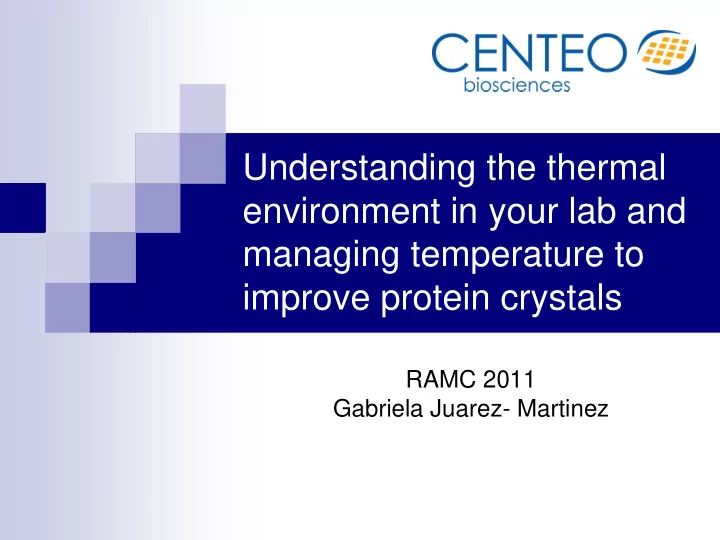

Understanding the thermal environment in your lab and managing temperature to improve protein crystals RAMC 2011 Gabriela Juarez- Martinez
Agenda Why is temperature important in biological crystallization Sources of temperature fluctuations in your lab Our solution:TG40 System Results
Three aspects of the use of temperature a crystallisation parameter, to be included in the (1) parameter space search alongside the type and concentration of precipitating agent, pH and buffer, protein concentration etc. a means to induce crystallisation by increasing the (2) supersaturation (commonplace in small molecule crystallisation, too rare for macromolecules) a means to optimise crystal growth, by separating (3) nucleation from the growth stage
The solubility of many proteins depends on temperature 86% of proteins tested by Christopher et al. (1998) J. Cryst. Growth 191 ,820, out of which 54% have direct temperature dependence and the rest have retrograde dependence. 9 of 13 retrograde solubility cases where in high salt, 4 of 13 in low salt, none from PEG. Results corroborated by Zhu et al. (2006) J. Struct. Biol. 154,297: 80% of proteins tested displayed temperature dependance. Temperature dependence is often shallow and can become virtually insignificant at high ionic strength, but becomes much steeper at low ionic strength, with PEG, MPD and organic solvents. Also retrograde solubility is more frequent at high ionic strength, in the cases where there still is temperature dependance (see Lloyd Haire in Bergfors ( ed ) Protein Crystallization , IUL 1999. Thus the temperature - solubility function is not a property of the protein itself but of the protein-salt system.
Temperature can influence the kinetics of crystallisation by: changing the speed of mass and heat diffusion in the (1) crystallisation solution. Low temperature can therefore sometimes increase the rate of nucleation, whilst reducing the rate of growth (see eg. Lorber & Giegé (1992) J. Cryst. Growth 122 ,168). changing the rate of equilibration in vapour diffusion, (2) dialysis, free interface diffusion …
Temperature as a means for inducing crystallisation Small-molecule crystallisers often use a controlled, slow drop in temperature to induce crystallisation It is a minimally invasive, reversible method to modify the level of supersaturation It is however much less used in the macromolecular crystallisation, due in part to the belief that the protein- dependence is too shallow (which is generally true only in high salt) and in part to the lack of dedicated apparatus For reports of the use of temperature shift in macromolecular crystallisation, see L. Lloyd Haire, in T.M. Bergfors ( ed ) Protein Crystallization , I.U.L. 1999, pp. 65-68 and refs therein.
Temperature as a means to separate the nucleation and growth stages of crystallisation The temperature-dependence of solubility can be used for modifying the supersaturation level with respect to protein of the solution during the course of the experiment – thus uncoupling the nucleation from the crystal growth stage
Temperature as one more parameter to test 1400 BMCD entries 1200 BMCD results compiled by Hampton Research, published 1000 in McPherson, Crystallization of Biological Macromolecules , 800 CSHL Press, 1999 600 400 200 0 -10°--1 0°-4° 5°-9° 10°-14 15°-19 20°-24 25°-29 30°-34 35°-39 40-100 “there is clearly room for more creative use of temperature” (McPherson,1999)
Current Methods No Temperature control Air conditioned rooms Fridges/Incubators
Sources of temperature fluctuations Type of air conditioning system Position air conditioning system Windows and doors Heating Sunlight Seasons Other lab equipment , inc: microscopes and PCs
TG40 System Screening 5 different temperatures 4 ° C to 60 ° C at ambient temperatue of 20 ° C Portable Programmable Temperature accuracy 1 ° C Compatible with other lab instruments
Reproducibility A 13.6 ° C 17.6 ° C 25.8 ° C B 11 ° C 19 ° C 21 ° C 100 m m A) Lysozyme (0.4M NaNO3) B) C-terminal Fragment of tetanus toxin TetC (0.2M Ammonium Sulphate & 20% PEG 4K)
T-G40 System – Temperature Optimization I 6 ° C – Twinned Crystals 10 ° C – Twinned Crystals (better) 22 ° C - Precip 14 ° C - Single Xtals 18 ° C - Precip Courtesy of Andrew Bent, Protein Crystallization Scientist
Thanks Emmanuel Saridakis NCSR “DEMOKRITOS”, Athens, Greece Imperial College Faculty of Medicine, London, U.K. Andrew Bent UK Pharmaceutical Company Dr. Susana Teixeira Keele University, UK and Institut Laue Langevin, France.
Recommend
More recommend